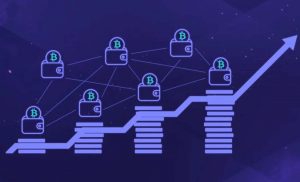The name comes from the English node – node. This very accurately describes the concept of a node in cryptocurrency. Every computer connected to the blockchain network and using the P2P protocol will be a node. And the stability of the entire network depends on its work and status.
What is a node in cryptocurrency in simple words
The basis of any digital money is a chain of blocks (Blockchain). It contains information about the number of coins issued and details of transactions.
Blockchain is a distributed ledger. Its functioning requires a decentralized network. The basic elements can be computers, smartphones, virtual servers or ASIC minerit devices. Software supporting a specific cryptocurrency is installed on them. They are called nodes.
Such an element is correctly represented in the form of an electronic wallet. Its database stores information about the amount and movement of all cryptocurrency of this type. Not only the data of its owner.
Caracteristici
The environment in which nodes exist is a peer-to-peer network. It allows different nodes to interact with each other. Common protocols operating in it include proof-of-work(PoW) and proof-of-ownership(PoS) consensus. Regardless of the choice of algorithms for the coin, it enables the transmission of information about new blocks and transactions.
5020 $
bonus pentru utilizatorii noi!
ByBit oferă condiții convenabile și sigure pentru tranzacționarea criptomonedelor, oferă comisioane mici, un nivel ridicat de lichiditate și instrumente moderne pentru analiza pieței. Suportă tranzacționarea spot și cu efect de levier și ajută comercianții începători și profesioniști cu o interfață intuitivă și tutoriale.
Câștigați un bonus de 100 $
pentru utilizatorii noi!
Cea mai mare bursă de criptomonede unde vă puteți începe rapid și în siguranță călătoria în lumea criptomonedelor. Platforma oferă sute de active populare, comisioane mici și instrumente avansate pentru tranzacționare și investiții. Înregistrarea ușoară, viteza mare a tranzacțiilor și protecția fiabilă a fondurilor fac din Binance o alegere excelentă pentru comercianții de orice nivel!
Why it’s needed
From a blockchain perspective, a node is the basic unit. There are decentralized networks that do not provide for the mining of new coins (no miners) or use alternative ways to protect information. However, the presence of nodes is a mandatory attribute of any cryptocurrency system. Depending on the specific blockchain, they perform the following functions:
- Verify adherence to rules (consensus).
- Exchange information (about transactions and the amount of funds).
- Keep a copy of confirmed transfers.
- Detect incorrect transactions.
- Protect the integrity of the peer-to-peer network.
- Find new blocks.
Classification
Since the tasks that nodes perform in a cryptocurrency network are different, the nodes themselves are not the same either. They differ in size and function in the blockchain they belong to. For example, the concept of a supernode is mainly applied to the NEM network (one of the blockchains). And the Basic Attention Token platform does not use them for mining.
Each node is considered equal. However, some play a more important role in how they maintain the network. Some nodes cannot store a full copy of the chain or verify transactions. Others, however, operate outside of their network.
Full nodes
If a device connected to the cryptocurrency network stores 100% of the current distributed ledger database, then such a node is called a full node. The reliability of the entire system, its scalability and speed of transaction confirmation depend on the number of such elements. The more of them there are in the system, the more stable it is.
Theoretically, as long as at least one device retains a full copy of the blockchain, the cryptocurrency network can be restored. With multiple independent computers and servers in different countries, the distributed ledger is maintained and constantly updated.
Full nodes are a guarantee of security. Since it is necessary to destroy all of them to stop the operation.
Information about the number of active full node cryptocurrency is in the public domain. For example, the work of bitcoin is supported by 9874 full nodes. Data from September 2, 2021, the site is bitnodes. This figure shows the servers and computers connected to the Internet at a particular moment in time.
Since some of the nodes may be temporarily unavailable, not all of them are full, the absolute number of existing bitcoin nodes is much higher. One of the Bitcoin Core developers, Luke Dasheer, estimates that in July 2021, the former’s network has approximately 62k registered nodes.
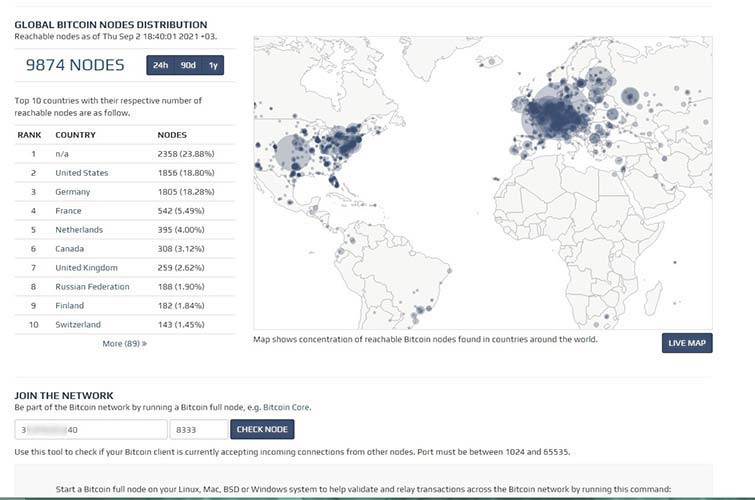
Trimmed
Not all users of the blockchain network can deploy a full node on their computer. One reason is the large size of the blockchain and e-wallet. Since the blockchain stores information about all transactions and coins issued, its size increases over time.
For example, in July 2021, to download the bitcoin database to your PC, you had to have a minimum of 352 GB of free hard disk space.
If there is not enough space, you can use a Pruned Full Node. It is considered full and participates in the transaction validation and voting protocol.
The difference of this node is that its size is set by the user. When the downloaded or re-validated portions of the blockchain exceed the set hard disk size, the old data is erased. Only the block header and information about its place in the chain remain.
Archival
When people apply the term Full Node without elaborating, they mean a node that contains a complete copy of the blockchain (starting from the first genesis block) with all transactions in progress.
It is fully independent and self-sufficient in active 24 / 7 mode. It is called archival. The only difference from the trimmed one is the amount of space it occupies on the hard disk.
If we carry out the classification further, then archive nodes are divided into those that mine new coins and are deprived of this opportunity.
Nodes of mining
The main task of such nodes is to mine new blocks of the distributed ledger. This requires complex cryptological calculations. Therefore, the main role in the process is played by hardware resources.
Mining can be organized using the power of video cards, a processor or ASIC. This is a device created for computing within 1 protocol for a specific cryptocurrency.
Nodes of mining can be either full or lightweight. Once a new block is found and confirmed, it is added to the blockchain. The miner receives remuneration for his work. Therefore, the presence of such nodes is possible only in a system that uses a PoW proof-of-work algorithm.
Betting Nodes
Not all chains adhere to the consensus of proof-of-work. Many cryptocurrencies use a PoS (proof-of-ownership) algorithm or a combination of PoW and PoS to create new blocks. The nodes responsible for pichetare are complete and are called bid nodes. The algorithm for working with them looks like this:
- Profile software is installed on a computer or virtual server. This includes Fat Wallet.
- Synchronization with the virtual currency blockchain is started.
- Coins are transferred to the wallet account.
- It is necessary to ensure constant communication with the rest of the network nodes (continuous connection to the Internet).
As a result, the owner of Staking Nodes receives a reward. The size depends on the ratio of invested funds to the total number of coins, freezing time. There is also an element of lottery.
For successful staking, the main thing is not the computing power of the equipment, but the volume of cryptocurrency stored on the wallet. This is the difference between earning on betting nodes and mining.
Facilitated
According to statistics, no more than 1% of bitcoin users own a full node. The rest of the number falls on lightweight nodes. That is, special applications that do not contain the entire version of the decentralized registry. They use block headers to validate transactions.
Therefore, Lightweight Nodes are not full-fledged elements of the blockchain and depend on full nodes. This is used by attackers to falsify and conduct fake transactions. Automated virtual money exchange services are the most vulnerable to such attacks.
Lightweight nodes
More commonly known as lightweight wallets or Simplified Payment Verification (SPV) clients. The most compact type of nodes in cryptocurrency operating in a blockchain environment.
Due to the fact that the database of such items contains only block headers, the emergence of multi-currency wallets became possible. They are installed on smartphones or as browser extensions.
SPV applications interact with the environment through a remote node. Do not affect the integrity and security of the network. Neither can validate other transactions.
That being said, Lightweight Nodes are in high demand. As they are easy to use, fast and undemanding on computing resources.
Lightweight Nodes
A special type that allows users to perform actions outside of the basic protocol. Lightning nodes are a kind of add-on to the blockchain. It is designed to free bitcoin from overload. As a result, the speed of transactions increases. Owners of such nodes receive a commission for each transfer. But it is insignificant – from 1 to 20 satoshis.
Masternodes
Such nodes do not add new blocks to the chain, but only check them. They have special control and regulation functions depending on the blockchain protocol they participate in.
The idea of masternodes was first implemented in the Dash cryptocurrency system (March 2014). There they have more powers than the regular ones:
- Carrying out instant transactions (InstantSend).
- Sending private transfers (PrivateSend).
- Assigning usernames to network users instead of cryptocurrency addresses.
- Each masternode is given one vote to decide whether to approve or reject protocol amendments to the Dash network.
The operation is collateral based. It acts as a PoS protocol. Operators need to hold a significant amount of their own cryptocurrency to operate a node. In turn, holders receive an annual income from the coins for their services.
This ensures that the most important nodes are financially incentivized. And as a result, stability and loyalty will increase. For this reason, masternodes are also known as authentication systems. The principle is similar to placing bets in a PoS system.
Noda after a fork
The reason for changing the source code of the coin can be:
- Switching to a different consensus validation protocol. For example, from PoW to PoS.
- Detection of critical bugs in the blockchain code.
- Introduction of masternodes into the system.
- Scaling of the cryptocurrency network.
The decision to conduct a fork is made by a general vote of the owners of full nodes. There are 2 possible options here.
Hard fork
Thecorrection of the code changes the algorithm of network coordination. This results in a blockchain that is incompatible with the previous version. Full nodes that supported the change update their software and form the ecosystem of the new coin. The consequence of a hard fork is a decrease in the number of Full Nodes in the network. This can have a negative impact on its security.
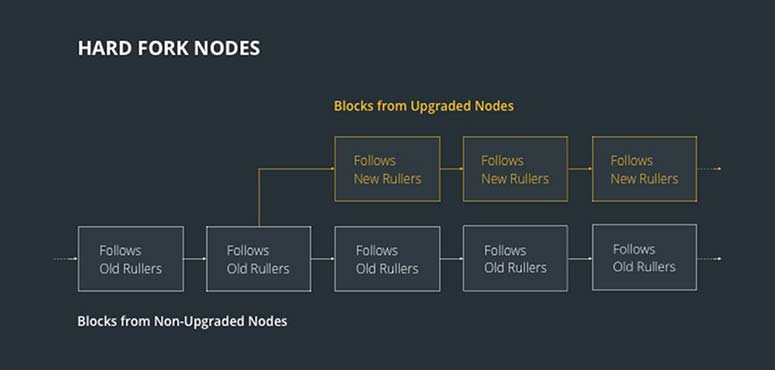
Soft fork
Such a change is also called a software change. In this case it is not necessary to upgrade. Both block chains will be equal. They will be able to participate in transaction confirmation.
An example of a soft fork is the introduction of the SegWit algorithm into the bitcoin blockchain. It took place on August 24, 2017. For the next 4 years, both nodes upgraded to the new version and those using the original software could make and confirm bitcoin transfers. Community separation did not happen. And the stability of the system did not suffer.
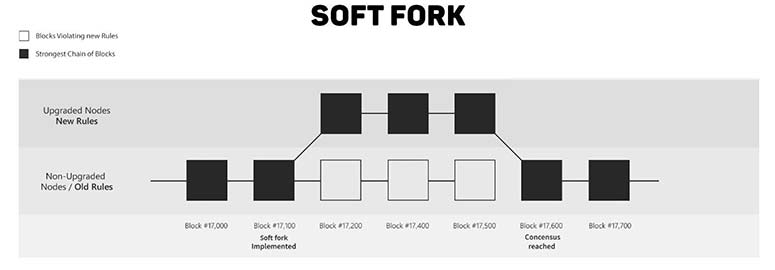
Starting a node
To open a full node, you need to fulfill a number of requirements. If previously it was possible to launch a node on weak hardware, now memory and processor power are a decisive factor in a successful deployment.
Before the startup procedure, the recommended configuration must be specified. It often differs for each of the existing cryptocurrencies. For example, the minimum requirements for installing a full bitcoin node are as follows:
- The device must have an up-to-date version of Windows, Mac OS X or Linux.
- 500GB or more of free disk space with a minimum read speed of 100MB/sec.
- The SSD is capable of 68MB random writes and 30.9MB random reads. At least 8 GB of random access memory (RAM).
- Broadband internet connection with a minimum download speed of 400 kilobits (50 kilobytes) per second. The connection must be unlimited.
A folder must be created to store the blockchain data in the file system. As of August 2021, 380 GB was required for synchronization.
After installing the client and updating the database, you need to allow incoming connection through TCP port 8333 in the firewall.
Challenges you may encounter when deploying on your own:
- Limited bandwidth or unstable internet connection. A reboot will be required if the node’s synchronization with the network is interrupted.
- Parts of known computer viruses have been introduced into the blockchain by hackers. It is impossible to infect a computer with such data. But antivirus programs move suspicious objects to quarantine. This makes it difficult for Bitcoin Core to operate. Most often this happens on Windows computers.
Thus, the independent launch of a full node requires the cost of purchasing equipment that meets certain requirements. Also – ensuring an uninterrupted Internet connection and the ability to use the command line.
VPS with nodes
Using a virtual private server is a convenient solution for a trader who decided to launch a personal node. In this case, you won’t have to worry about protection from DDoS attacks and sufficient connection bandwidth.
VPS allows you to deploy several masternodes on one server. You only need to order a dedicated IP-address for each configuration. In addition, renting a virtual server even with top-notch features will be cheaper than buying a computer and connecting it to high-speed Internet.
The only controversial point is that the deposit of coins for the operation of the masternode takes place on third-party equipment. Therefore, it is worth paying attention to the security measures and countermeasures against hacking a cryptocurrency wallet.
Earnings on nodes
Using the basic elements of the blockchain as a tool for investment is becoming increasingly popular. This is due to the decline in profits from mining. And with the fact that the number of digital currencies that allow you to earn in this way is constantly growing. And different coins use different protocols. This expands the opportunities for profit extraction.
Harvesting
This is the name of receiving remuneration for the work of nodes in the NEM environment, which uses the Proof-Of-Importance protocol. The peculiarity of the method is that one client provides the action of many accounts. The number of coins received is directly proportional to the rating or coefficient of importance. It is calculated by a set of such parameters:
- The volume of deposited coins.
- Account activity in transactions.
- Duration of coins in the wallet.
There are 2 ways for harvesting:
- Local. One profile – one computer. Currently, this method is rarely used. Clients who are connected have access to the private key of the profile. So there is a possibility of deposit theft.
- Delegated. In this case, an intermediary account is involved in harvesting. He does not control the wallet balance.
Leasing
A relatively new method of earning. It is applicable to cryptocurrency that uses the Proof-Of-Stake consensus. The leasing mechanism can be evaluated on the example of the Waves koin.
To make a profit, in addition to installing a node, you need coins. They will be stored on the wallet. The minimum amount is 1000 coins. But if there is no such money (on August 31, 2021 it is about $30 thousand) or do not want to invest the entire amount, you can use leasing.
To do this, you will still have to buy at least part of the necessary cryptocurrency (300-600), transfer it to your wallet and activate the function of leasing coins. Miners who accepted such conditions will transfer a share of their proceeds. The owner can disable the option at any time.

Profitable cryptocurrencies for making money from masternodes
The market of digital assets is a good source of income. In addition to mining and trading on the exchange, you can earn using masternode status.
As of September 2021, 224 cryptocurrencies use these nodes in their networks.
What you should pay attention to before choosing a cryptocurrency for investment:
- How the development of the project is going.
- How many crypto wallets support the coin.
- What is the minimum volume of koins needed to work with masternode.
- How much the cryptocurrency costs and what the yield is.
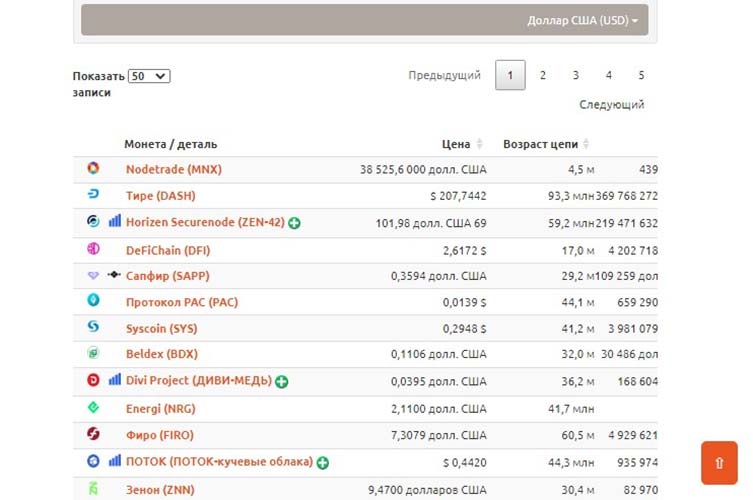
The table shows promising coins.
| Coin name | Minimum purchase amount for the deployment of nodes | Price as of 31.08.2021 |
|---|---|---|
| DASH | 1000 | $246,84 |
| Horizen (ZEN) | 42 | $102,68 |
| PIVX | 10 000 | $0,86 |
| Sapphire (SAPP) | 200 000 | $0,36 |
| GoByte (GBX) | 1000 | $0,03 |
Întrebări frecvente
📈 How to speed up bitcoin transaction approval?
There are several ways to reduce the time in which a bitcoin transfer will be approved. For example, you can try transaction gas pedals. For example, ViaBTC, BTC.com, ConfirmTX, 360 Bitcoin Accelerator.
❓ Which is better, a masternode or a full node?
Both types have similar functions. But with the first one, transactions are verified and recorded. With the second one, you can add a new block to the chain.
💰 Why run a full node if it doesn’t bring profit?
Users of the network get a reliable cryptocurrency wallet and can control their transactions without turning to external resources. If a person makes a lot of transfers, this will be important to them. There are also enthusiasts who popularize cryptocurrency. They are trying to make the system more reliable.
❔ If you mine coins by leasing, is noda needed?
No, customers can earn passive income simply by using the functions of their wallet. Unless, of course, they are leasing other people’s coins themselves. Then a full node needs to be installed.
🧾 Which providers are better to rent VPS?
There is no universal answer, the choice is up to the trader. Deciding to use a virtual server, it is necessary to study the market and familiarize yourself with the reviews of other clients. All information is freely available on the Internet.
Există o greșeală în text? Evidențiați-o cu mouse-ul și apăsați Ctrl + Introduceți.
Autor: Saifedean Ammous, un expert în economia criptomonedelor.
